Sustrans Coast and Castles
Riding the north east coast from Newcastle to Edinburgh
May 2015
Over the years Sustrans have put together a growing portfolio of long distance multi-day ride routes across the country. The problem is increasingly one of how to pick the next one to ride and, after our adventures on the C2C and in the Netherlands, Helen and I were looking for a suitable candidate for a few days in spring of 2015. Our gaze drifted to the north-east coast, an area we had not previously explored a great deal, other than when we finished our C2C ride back in 2011. The Coast and Castles (south) route looked an ideal candidate with two options both giving a total distance of about 300km, depending on route choice. In both cases the first half takes you from Newcastle up the Northumberland coast to Berwick. At this point there is the choice of heading inland, up the Tweed valley, towards 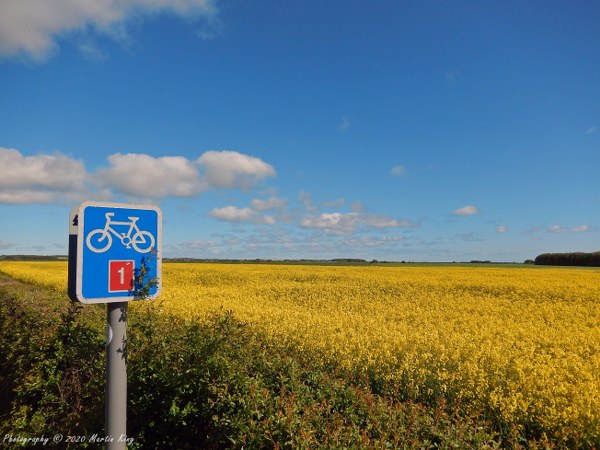 Peebles before turning north and over the hills and down to Edinburgh, a total distance of some 320km. Alternatively you can continue to hug the coastline up to Eyemouth and across via Dunbar to Edinburgh, a total distance of around 275km. Strangely the coastal route is actually hillier but the shorter distance meant that we could logistically squeeze it into a three day holiday which would fit nicely during the Spring Bank Holiday week at the end of May. Sorted.
Peebles before turning north and over the hills and down to Edinburgh, a total distance of some 320km. Alternatively you can continue to hug the coastline up to Eyemouth and across via Dunbar to Edinburgh, a total distance of around 275km. Strangely the coastal route is actually hillier but the shorter distance meant that we could logistically squeeze it into a three day holiday which would fit nicely during the Spring Bank Holiday week at the end of May. Sorted.
The route is aptly named and there are numerous castles spread along the full route. The Northumberland coast is probably less well known than many parts of the UK but it has much to commend it, not just from a cycling perspective but also in terms of places of interest and sights to visit and explore. And if you're into your castles then it really should be on your bucket list. Planning was pretty straightforward as our dates were already decided, we quickly decided that riding from south (Newcastle) to north (Edinburgh) was the obvious way to tackle it. And the direct rail link between the two cities meant that getting ourselves back to the start (and our car) would be easy enough. We found some suitable accommodation online, two pubs at roughly equidistant points along the route, and decided to book these head of setting off, just in case. As is our normal modus operandi, we would be travelling as light as possible with the bare minimum of clothing and extras. It has always worked in the past. Just to be safe we also booked the return train journey from Edinburgh, the drawback to that being that it meant we had a deadline for arriving in Edinburgh on day 3 which added some pressure on what was, admittedly, a slightly shorter day. So, let's go ride the Coast and Castles...
Day 1: Newcastle to Alnwick (89km, 510m of ascent)
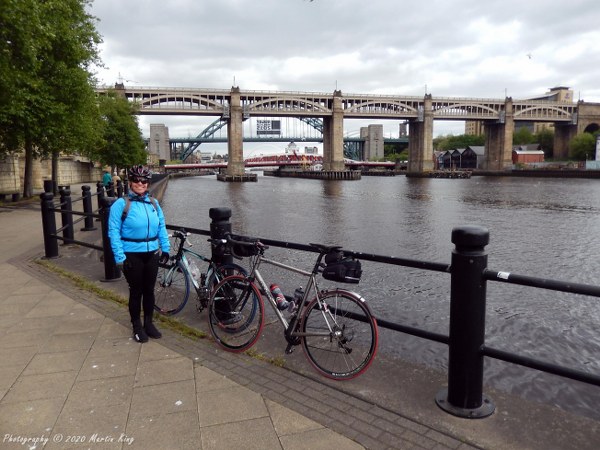 In reality our first day was just a half day as we didn't set out riding until lunchtime. The morning was spent throwing the bikes in the back of the car and driving across from Cumbria to Newcastle, finding somewhere to leave the car and then rolling down to the riverside and the official start of our Coast and Castles ride. By the time we had taken a few photos to commemorate the start it was knocking on about 12.30 but we wanted to get some miles in before we stopped for any food. Time to get cracking.
In reality our first day was just a half day as we didn't set out riding until lunchtime. The morning was spent throwing the bikes in the back of the car and driving across from Cumbria to Newcastle, finding somewhere to leave the car and then rolling down to the riverside and the official start of our Coast and Castles ride. By the time we had taken a few photos to commemorate the start it was knocking on about 12.30 but we wanted to get some miles in before we stopped for any food. Time to get cracking.
The start of the Coast and Castles is spectacular in an industrial sort of way as we pedalled along the riverside path, with the Tyne on our right and notable landmarks seemingly at every turn of our heads – the Tyne Bridge, the Sage, the Baltic Centre, the Millennium footbridge. Eventually we left the centre of Newcastle behind and wound our way through the less salubrious parts of the Tyneside industrial landscape through Wallsend to Tynemouth, all very familiar from our C2C crossing some 4 years ago. Just past the signpost which marks the end of the C2C is the ruined Tynemouth Castle alongside the Priory on a headland overlooking the beach, our first castle of the ride. Time pressures prevented us from having a closer look, we really will have to come back and spend some more time in the area.
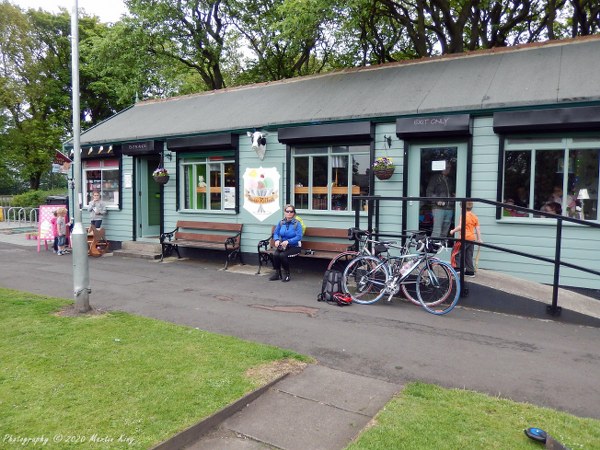 From here our route turned north and hugged the coastline as we passed through the frenetic seaside towns of Cullercoats and Whitley Bay, typical of so many British seaside resorts with arcades and fish and chip shops in seemingly equal quantity. A real throwback to holidays I remember from the 60s and 70s. With long sandy beaches it is easy to see why the crowds are drawn here although in what was a half term week there were precious few beach goers in view, perhaps they were all in the chippies getting lunch? The fact that it was a decidedly grey day with temperatures that were not really worth writing home about may also have had something to do with it. The Sustrans route heads along the beachfront on a wide promenade alongside the A193, diverting away from the main road to pass St Mary's Lighthouse and then on to the delightfully named Seaton Sluice where we crossed the Seaton Burn. This stretch of coast has a decidedly industrial tone, which continued for some distance as we carried on to Blyth by which time we felt that it would be decent to call a lunch break, having covered some 33 kilometres. We came across Ridley Park, a large open greenspace amongst the urban sprawl of Blyth and found a hidden gem at its heart, Mr Ridleys Ice Cream Parlour. Perfect! It was, in truth, another throwback, but had a charm and appeal all of its own, nestling under the canopy of trees in the centre of the park. Friendly service and some excellent fare set us up for a thoroughly enjoyable lunch to recharge our batteries.
From here our route turned north and hugged the coastline as we passed through the frenetic seaside towns of Cullercoats and Whitley Bay, typical of so many British seaside resorts with arcades and fish and chip shops in seemingly equal quantity. A real throwback to holidays I remember from the 60s and 70s. With long sandy beaches it is easy to see why the crowds are drawn here although in what was a half term week there were precious few beach goers in view, perhaps they were all in the chippies getting lunch? The fact that it was a decidedly grey day with temperatures that were not really worth writing home about may also have had something to do with it. The Sustrans route heads along the beachfront on a wide promenade alongside the A193, diverting away from the main road to pass St Mary's Lighthouse and then on to the delightfully named Seaton Sluice where we crossed the Seaton Burn. This stretch of coast has a decidedly industrial tone, which continued for some distance as we carried on to Blyth by which time we felt that it would be decent to call a lunch break, having covered some 33 kilometres. We came across Ridley Park, a large open greenspace amongst the urban sprawl of Blyth and found a hidden gem at its heart, Mr Ridleys Ice Cream Parlour. Perfect! It was, in truth, another throwback, but had a charm and appeal all of its own, nestling under the canopy of trees in the centre of the park. Friendly service and some excellent fare set us up for a thoroughly enjoyable lunch to recharge our batteries.
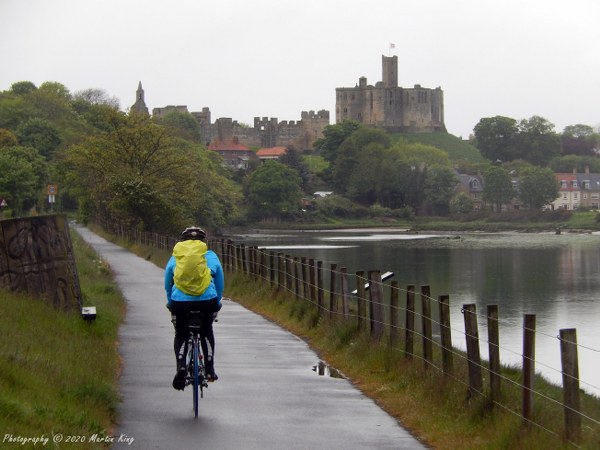 Having navigated our way through Blyth and crossed the River Blyth inlet we were back on NCN Route 1 and heading back to the coast. By this time the afternoon greyness had degenerated into proper rain which, to be fair, had been forecast. There was nothing for it but to put our heads down and crack on. The next stretch runs alongside the busy A189 bypassing Newbiggin-by-the-Sea. Not the best Sustrans offering I have to say and also not the best time for Helen to pick up a puncture. Fixing this in the rain right next to a busy roundabout on the A189 does not go down as a highlight of our holiday, memorable though it proved to be. We were on our way again soon enough though and shortly after this NCN1 took us off the main road, into Lynemouth and on to Cresswell. We now had the North Sea for company once again and followed a damp coast road north towards Druridge Bay nature reserve. Here Sustrans follows an off road route through the reserve and our attempts to follow this on road bikes left us feeling less than comfortable. We retreated, opting instead for a tarmac diversion round to the north end of Druridge Bay to rejoin the official route at Amble. Here we headed on to our second castle of the day, the spectacular Warkworth Castle, an imposing medieval ruin on the River Coquet at the heart of the village. Sadly, time was against us and we arrived here after closing time which meant we had no opportunity to explore. Next time.
Having navigated our way through Blyth and crossed the River Blyth inlet we were back on NCN Route 1 and heading back to the coast. By this time the afternoon greyness had degenerated into proper rain which, to be fair, had been forecast. There was nothing for it but to put our heads down and crack on. The next stretch runs alongside the busy A189 bypassing Newbiggin-by-the-Sea. Not the best Sustrans offering I have to say and also not the best time for Helen to pick up a puncture. Fixing this in the rain right next to a busy roundabout on the A189 does not go down as a highlight of our holiday, memorable though it proved to be. We were on our way again soon enough though and shortly after this NCN1 took us off the main road, into Lynemouth and on to Cresswell. We now had the North Sea for company once again and followed a damp coast road north towards Druridge Bay nature reserve. Here Sustrans follows an off road route through the reserve and our attempts to follow this on road bikes left us feeling less than comfortable. We retreated, opting instead for a tarmac diversion round to the north end of Druridge Bay to rejoin the official route at Amble. Here we headed on to our second castle of the day, the spectacular Warkworth Castle, an imposing medieval ruin on the River Coquet at the heart of the village. Sadly, time was against us and we arrived here after closing time which meant we had no opportunity to explore. Next time.
We now had just a little way left to go at the end of our first day, mostly along the main A1068 road. By now the rain had returned and this stretch proved to be pretty dreary and unpleasant but mercifully short. As we cruised down the hill into the village of Alnmouth and spied the sign of the Sun Inn on the main street our hearts leapt at the thought of a warm welcome, a hot shower and something to eat and drink. It had been an adventurous and eventful first day.
Day 2: Alnwick to Eyemouth (107km, 1355m of ascent)
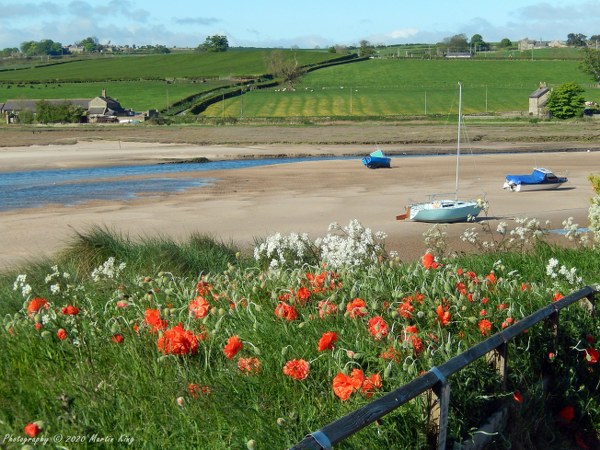 The next morning dawned gloriously sunny and bright, a real contrast to our first day on the Coast and Castles. This was the crunch day, both long and hilly, it was going to be quite a test. Still, with the prospect of a decent day of weather we could face it with a smile.
The next morning dawned gloriously sunny and bright, a real contrast to our first day on the Coast and Castles. This was the crunch day, both long and hilly, it was going to be quite a test. Still, with the prospect of a decent day of weather we could face it with a smile.
After a hearty breakfast we had time to explore the village briefly before setting off on our way. It's strange how places look so much nicer in morning sunshine than evening drizzle and Alnmouth was certainly no exception. It has history which harks back to the 18th century when it was a renowned shipping harbour with trade links wide and far, though it is a more modest village these days. Nevertheless in the spring sunshine it was cheery and colourful, especially surrounded by vibrant fields of poppies and yellow rapeseed.
Suitably energised we loaded up our bikes ready for the day ahead and rolled out, once again on NCN1, winding along country lanes to the coastal village of Boulmer, renowned as the home of the RAF base and which, until September 2015, was also home to the Search and Rescue helicopters so familiar to walkers and climbers in the Lake District. NCN1 now took us inland for a while before once again heading out to the coast. A short detour took us down to the lovely fishing village of Craster with its well known harbour. Although we had only covered a short distance by this time it seemed an opportune moment to enjoy a coffee stop and Helen and I rode through the village to find a suitable spot, namely the Shoreline Café. Perfect. Craster harbour is very photogenic with its harbour walls, lobster creels and the fishermen’s cottages lining the harbour edge. The harbour walls date back to the early 1900s and were built to commemorate a local military captain who fell in the Tibetan Conflict of 1904. Probably far more useful than a statue!
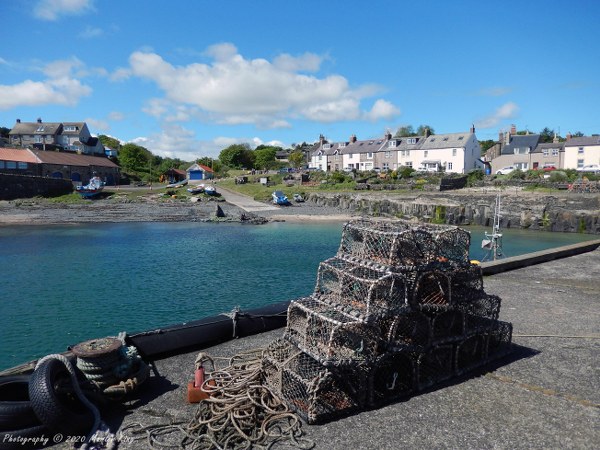 From Craster we rejoined NCN1, passing yet more rape fields of yellow contrasting gloriously with the clear blue skies, and bimbled our way past the ruined Dunstanburgh Castle which sits out on a lonely headland looking out across the North Sea. I imagine it can be a wild and inhospitable place but today it looked very serene with plenty of visitors traipsing across the fields to reach the tumbledown walls. Our day lay ahead and once again Sustrans invited us inland on a network of lanes and byways threading a route through the farmland to Seahouses, another coastal harbour. From here we joined a busy B road bound for the village of Bamburgh and its world famous castle, yet another coastal fortress but this one in far better condition than Dunstanburgh down the road. As we rode towards the village the castle completely dominated our view, standing high on land above the beach, rather like a proper fairytale castle. The present castle seemingly started life originally as a Celtic stronghold back around AD400 but was destroyed by the Vikings in AD993, only to be rebuilt by the Normans a few years later. Unlike many of the castles on this route Bamburgh is intact and in full restorative order, having been acquired by the Armstrong family in 1894 who still retain ownership to this day. Given the size of it I imagine the heating bills alone are pretty horrendous!
From Craster we rejoined NCN1, passing yet more rape fields of yellow contrasting gloriously with the clear blue skies, and bimbled our way past the ruined Dunstanburgh Castle which sits out on a lonely headland looking out across the North Sea. I imagine it can be a wild and inhospitable place but today it looked very serene with plenty of visitors traipsing across the fields to reach the tumbledown walls. Our day lay ahead and once again Sustrans invited us inland on a network of lanes and byways threading a route through the farmland to Seahouses, another coastal harbour. From here we joined a busy B road bound for the village of Bamburgh and its world famous castle, yet another coastal fortress but this one in far better condition than Dunstanburgh down the road. As we rode towards the village the castle completely dominated our view, standing high on land above the beach, rather like a proper fairytale castle. The present castle seemingly started life originally as a Celtic stronghold back around AD400 but was destroyed by the Vikings in AD993, only to be rebuilt by the Normans a few years later. Unlike many of the castles on this route Bamburgh is intact and in full restorative order, having been acquired by the Armstrong family in 1894 who still retain ownership to this day. Given the size of it I imagine the heating bills alone are pretty horrendous!
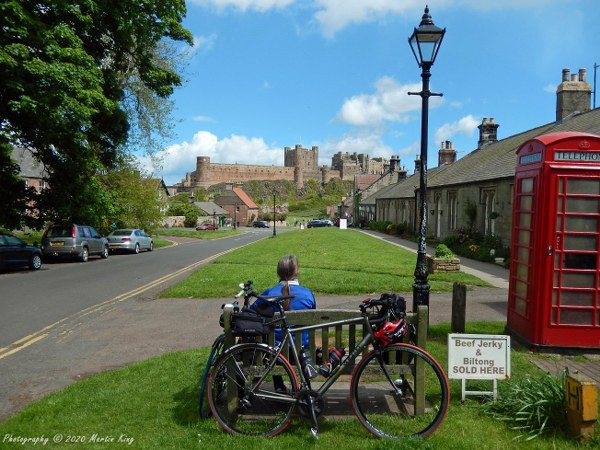 Bamburgh village is pretty, centred around a grassy green with houses and a few shops, one of which was where we found a tasty takeaway lunch of sandwiches, cake and coffee. Outside was a bench seat with a perfect view of the castle, an ideal spot to sit and enjoy the moment which we duly did. Suitably refreshed it was time to move on, we still had a way to go and the clock was ticking. The next section of NCN1 heads inland, winding this way and that through colourful farmland (more rape fields) and still with those blue skies, before crossing the A1 and tracking this main London-Edinburgh road for several kilometres, albeit at a respectful distance. The views east out across the fields to the North Sea coast were spectacular and we could now see ahead the distinctive Lindisfarne Island as it got ever nearer. Eventually our road plunged back down, recrossing the A1 and down to Beal where we took a detour to the very edge of the Lindisfarne tidal causeway road. On another day we might have been tempted to undertake the crossing but we weren't sure of the tide times and, in any case, we didn't have a great deal of time as a coffee stop was imminent and we were well aware of our priorities.
Bamburgh village is pretty, centred around a grassy green with houses and a few shops, one of which was where we found a tasty takeaway lunch of sandwiches, cake and coffee. Outside was a bench seat with a perfect view of the castle, an ideal spot to sit and enjoy the moment which we duly did. Suitably refreshed it was time to move on, we still had a way to go and the clock was ticking. The next section of NCN1 heads inland, winding this way and that through colourful farmland (more rape fields) and still with those blue skies, before crossing the A1 and tracking this main London-Edinburgh road for several kilometres, albeit at a respectful distance. The views east out across the fields to the North Sea coast were spectacular and we could now see ahead the distinctive Lindisfarne Island as it got ever nearer. Eventually our road plunged back down, recrossing the A1 and down to Beal where we took a detour to the very edge of the Lindisfarne tidal causeway road. On another day we might have been tempted to undertake the crossing but we weren't sure of the tide times and, in any case, we didn't have a great deal of time as a coffee stop was imminent and we were well aware of our priorities.
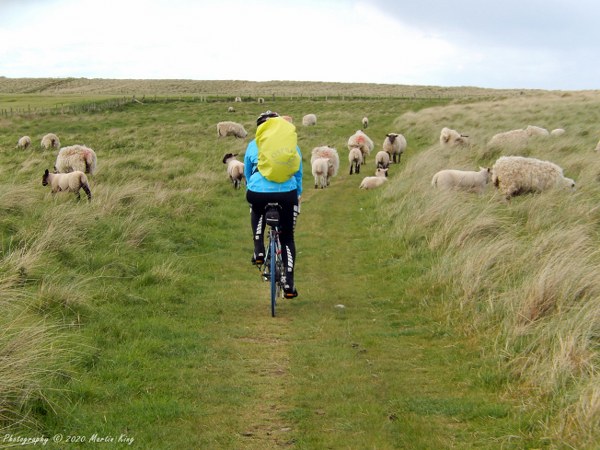 The Barn at Beal is cycle friendly, as demonstrated by the bike racks by the terrace, overlooking the sea a few hundred yards away. The sun was still shining and we were soon embracing a coffee and some cake, poring over the map and taking in the views out towards Lindisfarne Island and beyond. This is what cycle touring is all about. From Beal our route once again went off road, and this time we embraced it though, had we been aware that this was an ex military area with potentially unexploded objects hidden beneath our wheels, we might have thought twice. The picture of Helen riding ahead of me through a field full of grazing sheep is one that will stay with me and not one that I had expected when we were planning this ride. The cross country path rejoined civilisation in the middle of Berwick on Tweed golf club with a warning to beware of flying golf balls. This part of Northumberland is clearly dangerous! The rough and tumble of the cross-country section did cause an additional problem as Helen experienced her second puncture of the ride which left us dangerously short in the inner tube department. Fortunately, having rejoined proper tarmac, we were now rolling into Berwick and managed to locate a Halfords store on the edge of town, still open for business despite the late hour in the afternoon. We bought two tubes and a replacement tyre, just to be on the safe side.
The Barn at Beal is cycle friendly, as demonstrated by the bike racks by the terrace, overlooking the sea a few hundred yards away. The sun was still shining and we were soon embracing a coffee and some cake, poring over the map and taking in the views out towards Lindisfarne Island and beyond. This is what cycle touring is all about. From Beal our route once again went off road, and this time we embraced it though, had we been aware that this was an ex military area with potentially unexploded objects hidden beneath our wheels, we might have thought twice. The picture of Helen riding ahead of me through a field full of grazing sheep is one that will stay with me and not one that I had expected when we were planning this ride. The cross country path rejoined civilisation in the middle of Berwick on Tweed golf club with a warning to beware of flying golf balls. This part of Northumberland is clearly dangerous! The rough and tumble of the cross-country section did cause an additional problem as Helen experienced her second puncture of the ride which left us dangerously short in the inner tube department. Fortunately, having rejoined proper tarmac, we were now rolling into Berwick and managed to locate a Halfords store on the edge of town, still open for business despite the late hour in the afternoon. We bought two tubes and a replacement tyre, just to be on the safe side.
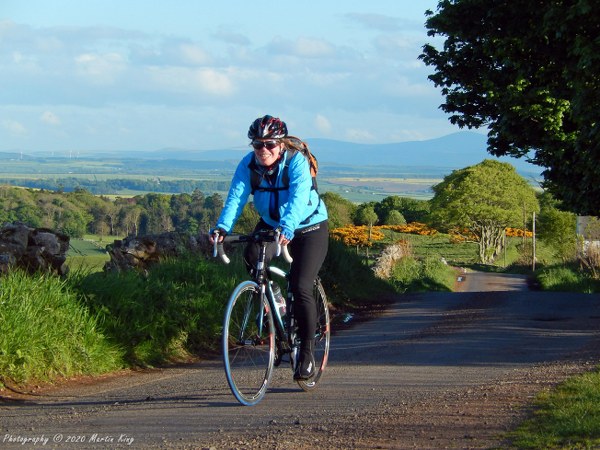 Berwick is the parting of the ways in Coast and Castles terms. NCN1 now heads inland along the river Tweed while we opted to continue north, now following NCN Route 76. We had just 20 kilometres left but they proved to be as tough as anything that had gone before, particularly after a long day. More country lanes climbed and climbed as we crossed Lamberton Moor up at over 200 metres to reach the village of Ayton and our final, flying downhill run on the B6355 alongside the Eye Water into the port of Eyemouth, almost incidentally passing Ayton Castle as we hurtled by. Having checked into the Home Arms Hotel, a B and B with no frills, we wandered through the streets to find somewhere to eat and drink, happening eventually on the oddly named Oblo Bar and Bistro where we rested our weary legs over a pint or two. It had been a long day, with plenty to reflect on as we looked ahead to our final day of this adventure.
Berwick is the parting of the ways in Coast and Castles terms. NCN1 now heads inland along the river Tweed while we opted to continue north, now following NCN Route 76. We had just 20 kilometres left but they proved to be as tough as anything that had gone before, particularly after a long day. More country lanes climbed and climbed as we crossed Lamberton Moor up at over 200 metres to reach the village of Ayton and our final, flying downhill run on the B6355 alongside the Eye Water into the port of Eyemouth, almost incidentally passing Ayton Castle as we hurtled by. Having checked into the Home Arms Hotel, a B and B with no frills, we wandered through the streets to find somewhere to eat and drink, happening eventually on the oddly named Oblo Bar and Bistro where we rested our weary legs over a pint or two. It had been a long day, with plenty to reflect on as we looked ahead to our final day of this adventure.
Day 3: Eyemouth to Edinburgh (87km, 750m of ascent)
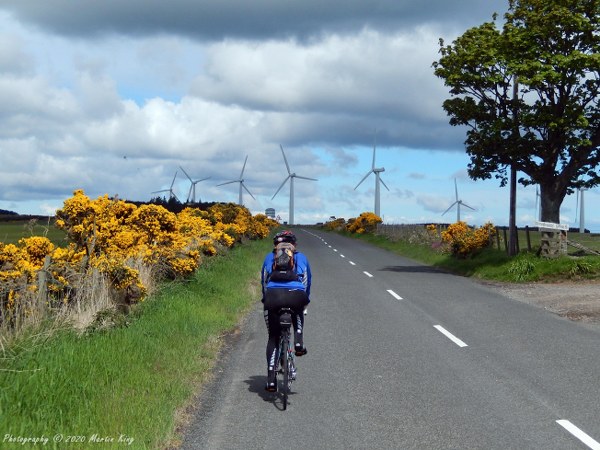 Eyemouth is an historic fishing village right on the north-east corner of the land east of Edinburgh and north of Newcastle and seems, therefore, a perfect choice for an overnight stop. We had some time to explore a bit more following our breakfast, and rolled through the quiet streets examining statues and monuments before, finally, girding our loins for the long climb that starts the final day's ride of the Coast and Castles ride. Having enjoyed the descent the previous evening we knew what was coming, but that didn't make it any easier. We were on quiet backroads that stretched long and straight before us, high up onto Coldingham Moor, the highest point on the entire ride at 224 metres. By now we had joined the A1107 main road, it being the only option over the moor, and we were surrounded by dozens of massive wind turbines. This was the romantically named Drone Hill Wind Farm and must be a local landmark, visible for many a mile.
Eyemouth is an historic fishing village right on the north-east corner of the land east of Edinburgh and north of Newcastle and seems, therefore, a perfect choice for an overnight stop. We had some time to explore a bit more following our breakfast, and rolled through the quiet streets examining statues and monuments before, finally, girding our loins for the long climb that starts the final day's ride of the Coast and Castles ride. Having enjoyed the descent the previous evening we knew what was coming, but that didn't make it any easier. We were on quiet backroads that stretched long and straight before us, high up onto Coldingham Moor, the highest point on the entire ride at 224 metres. By now we had joined the A1107 main road, it being the only option over the moor, and we were surrounded by dozens of massive wind turbines. This was the romantically named Drone Hill Wind Farm and must be a local landmark, visible for many a mile.
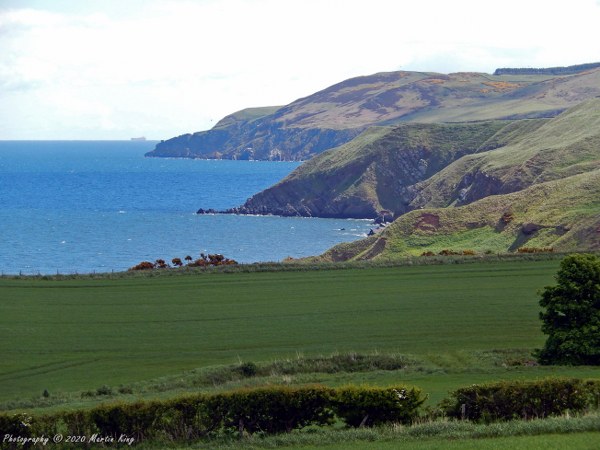 Of course, having climbed we then had the descent to enjoy and this took us quickly down to a dramatic and tight right turn leading to a steep hill down to an incongruous caravan park rammed into the hillside at Pease Bay. Then it was up – again! At this point the views back along the coastal cliffs to the south were dramatic and worthy of a moment with the camera. The next section of NCN76 is less well appointed as we negotiated many workings and obstacles, running alongside the coastal main railway line and closing in on the looming towers of Torness Nuclear Power Station followed by the rather ugly cement works on the outskirts of Dunbar which dominate this stretch of the coast. If industrial is your thing then this part of the ride is probably for you! It was along here that we suffered our third mechanical of the ride, a broken spoke on my front wheel. It was, thankfully, easy enough to wind the spoke round an adjacent one, thereby allowing us to continue. I could sort it out properly when we got home, in the meantime did I mention we had a train to catch?
Of course, having climbed we then had the descent to enjoy and this took us quickly down to a dramatic and tight right turn leading to a steep hill down to an incongruous caravan park rammed into the hillside at Pease Bay. Then it was up – again! At this point the views back along the coastal cliffs to the south were dramatic and worthy of a moment with the camera. The next section of NCN76 is less well appointed as we negotiated many workings and obstacles, running alongside the coastal main railway line and closing in on the looming towers of Torness Nuclear Power Station followed by the rather ugly cement works on the outskirts of Dunbar which dominate this stretch of the coast. If industrial is your thing then this part of the ride is probably for you! It was along here that we suffered our third mechanical of the ride, a broken spoke on my front wheel. It was, thankfully, easy enough to wind the spoke round an adjacent one, thereby allowing us to continue. I could sort it out properly when we got home, in the meantime did I mention we had a train to catch?
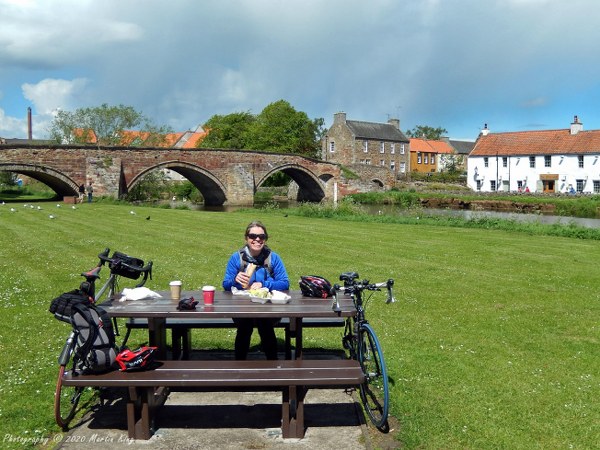 Dunbar, by comparison, is much more enjoyable. An ancient Scottish town, once a royal burgh it is now little more than a dormitory town for Edinburgh, but is birthplace of the renowned Scottish explorer, naturalist and conservationist John Muir. Out in the Forth estuary is the distinctive rocky outcrop of Bass Rock. With its ancient harbour and castle remains this is another place that was deserving of rather more of our attention than we were able to afford. Another time (I seem to have heard that before). NCN76 now turns east and heads inland, bound first of all for East Linton and then into the Tyne Valley (no, not that river Tyne) where we found our next castle, the ruins of Hailes Castle which looked to be popular with picnicking families. The road continued to wind its way pleasantly upstream and on to the little town of Haddington, another royal burgh and the administrative centre of East Lothian, and which straddles the river. This seemed like a top spot for lunch, so we found a sandwich shop for takeaway coffee and mini baguettes in the centre of town and retired to a large grassy area on the banks of the river near the old stone twelfth century Nungate Bridge. Perfect and a lovely way to end the morning's efforts.
Dunbar, by comparison, is much more enjoyable. An ancient Scottish town, once a royal burgh it is now little more than a dormitory town for Edinburgh, but is birthplace of the renowned Scottish explorer, naturalist and conservationist John Muir. Out in the Forth estuary is the distinctive rocky outcrop of Bass Rock. With its ancient harbour and castle remains this is another place that was deserving of rather more of our attention than we were able to afford. Another time (I seem to have heard that before). NCN76 now turns east and heads inland, bound first of all for East Linton and then into the Tyne Valley (no, not that river Tyne) where we found our next castle, the ruins of Hailes Castle which looked to be popular with picnicking families. The road continued to wind its way pleasantly upstream and on to the little town of Haddington, another royal burgh and the administrative centre of East Lothian, and which straddles the river. This seemed like a top spot for lunch, so we found a sandwich shop for takeaway coffee and mini baguettes in the centre of town and retired to a large grassy area on the banks of the river near the old stone twelfth century Nungate Bridge. Perfect and a lovely way to end the morning's efforts.
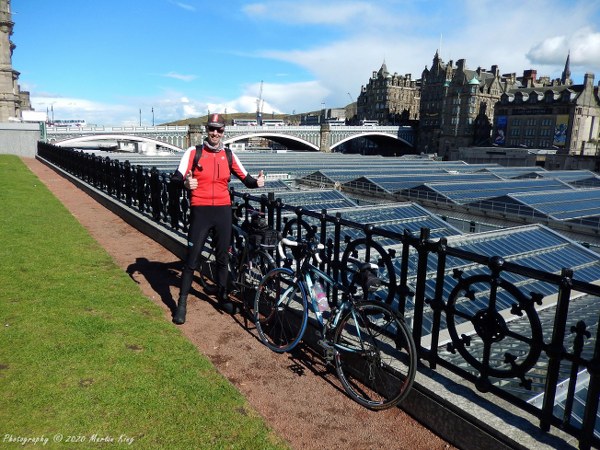 From here it was easy to think we were on the home stretch. If only. We still had some 35 kilometres to go, and we had a train to catch. No pressure! From Haddington, NCN76 now picks up the disused Haddington to Longniddry railway, a shared use path which took us across country and dropped us back onto the coast at the wonderfully named Longniddry village. Here we continued along the coast path, alongside the John Muir Way, through the Longniddry Bents, a series of dunes along the Forth estuary. Now there really was a feeling of being in the home straight as we could see Arthur's Seat in Edinburgh ahead of us, once we got past the industrial delight of Preston Pans power station, another monument to modern times. Next up was Musselburgh, another ancient coastal burgh, on the River Esk famous for its racecourse and its lovely little harbour, which incidentally was where my daughter got married the previous summer. The final part of our ride took us along the coast at Portobello, and then right into the heart of the city, following the main road through Meadowbank rather than yet another disused railway, and eventually dropping us into the busy rush hour streets to the north of Princes Street and Waverley Station, our final destination, and where our train would hopefully be waiting. Helen almost fell off her bike in relief, our race against time had been a total success and we had achieved what we set out to do, namely ride from Newcastle to Edinburgh in just 3 days, through wind, rain and sunshine. It had been a great adventure with much to reflect on as we sat in our train seats, enjoying a celebratory drink, and sped back to Newcastle, much of our journey alongside the very route we had spent 3 days riding but which took just 90 minutes on the train. Now, there's an irony.
From here it was easy to think we were on the home stretch. If only. We still had some 35 kilometres to go, and we had a train to catch. No pressure! From Haddington, NCN76 now picks up the disused Haddington to Longniddry railway, a shared use path which took us across country and dropped us back onto the coast at the wonderfully named Longniddry village. Here we continued along the coast path, alongside the John Muir Way, through the Longniddry Bents, a series of dunes along the Forth estuary. Now there really was a feeling of being in the home straight as we could see Arthur's Seat in Edinburgh ahead of us, once we got past the industrial delight of Preston Pans power station, another monument to modern times. Next up was Musselburgh, another ancient coastal burgh, on the River Esk famous for its racecourse and its lovely little harbour, which incidentally was where my daughter got married the previous summer. The final part of our ride took us along the coast at Portobello, and then right into the heart of the city, following the main road through Meadowbank rather than yet another disused railway, and eventually dropping us into the busy rush hour streets to the north of Princes Street and Waverley Station, our final destination, and where our train would hopefully be waiting. Helen almost fell off her bike in relief, our race against time had been a total success and we had achieved what we set out to do, namely ride from Newcastle to Edinburgh in just 3 days, through wind, rain and sunshine. It had been a great adventure with much to reflect on as we sat in our train seats, enjoying a celebratory drink, and sped back to Newcastle, much of our journey alongside the very route we had spent 3 days riding but which took just 90 minutes on the train. Now, there's an irony.
The Coast and Castles cycle ride had, for us, been a thoroughly enjoyable 3 days on the bikes, taking us through some lovely countryside with spectacular sights along the way. Castles aplenty and coast in abundance, so it definitely lives up to its name. Our three days were about right, I feel, but it does leave me wanting to return for a proper holiday based somewhere along the Northumberland coast to revisit some of the places we passed through. And I feel that, on balance, I would also like to tackle the inland route as well, to say we have done the Coast and Castles properly. But that will be another story.